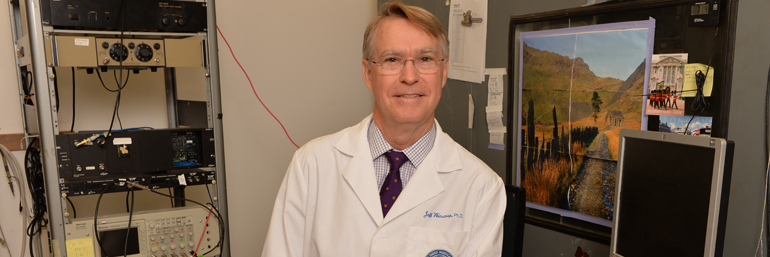Jun 29

Get to Know: Jeffrey Wenstrup, Ph.D., professor of anatomy and neurobiology
When the weather turns warm, you’re likely to find Jeffrey Wenstrup, Ph.D., in Montana, Utah or Wyoming, looking for the best fly-fishing. While he’s there, the director of NEOMED’s Hearing Research Group puts his understanding of biology to work to figure out what will appeal to the fish he’s trying to catch.
Like many professional paths, Dr. Wenstrup’s was anything but a straight line to his specialty in researching connections between hearing and emotions. First hired as an assistant professor of neurobiology at NEOMED in 1990, Dr. Wenstrup worked his way up, eventually becoming professor and chair of the Department of Anatomy and Neurobiology in 2008. Along the way, he was also appointed as the associate dean of research for the College of Medicine. As director of the Hearing Research Group, he oversees scientists who seek to understand the brain mechanisms responsible for hearing and vocal communication.
All of the twists and turns of this scientist’s career path have played a part in his development. By the time he graduated from high school, he knew his childhood dream of becoming a physician wasn’t going to be the right fit for him—but what was? He left his hometown of Cincinnati to study philosophy at St. Louis University in St. Louis, Missouri, where philosophy of science courses always piqued his interest the most. He went on to earn a Ph.D. in physiology with a minor in neuroscience studies from the Indiana University School of Medicine in Bloomington, Indiana. It was during his time in Bloomington that Dr. Wenstrup became fascinated with work in the research labs that would ultimately shape the direction of his career.
“I became really interested in working with bats, and how the brain was involved in their use of echolocation,” said Dr. Wenstrup. “To survive, they must rely on this mechanism to be aware of their surroundings and to locate the hundreds of insects they consume each night.”
His research work first led him to Austin, Texas, as a postdoctoral research fellow at the University of Texas Department of Zoology. Dr. Wenstrup then traveled to Berkeley, California, as a postdoctoral research fellow and lecturer at the University of California. Following this, he then headed overseas to conduct research at the Federal Republic of Germany Zoological Institute in Munich.
Research Meeting Offers Opportunities
Since joining NEOMED in 1990, Dr. Wenstrup, along with other faculty and student researchers, has traveled each year to the Association for Research in Otolaryngology’s Annual MidWinter Meeting. This year, alongside Ph.D candidates Zahra Ghasemahmad, Alexandra Niemczura and Krish Nair, a first-year student in the College of Medicine, Dr. Wenstrup presented research that examined the differences between how male and female mice use vocal cues.
Dr. Wenstrup and his collaborators study mouse (and bat) communication to look more closely into the brain’s mechanisms for emotional communication. “The ultimate goal of this research is to learn how brain centers analyze the emotional aspects of speech, how brain mechanisms orchestrate emotional responses to speech sounds, and how other senses and our own internal emotional state affect our understanding of the meaning of speech,” said Dr. Wenstrup.
The answers may lead to insights into human communication. For Dr. Wenstrup, the journey is just as interesting as the destination.


